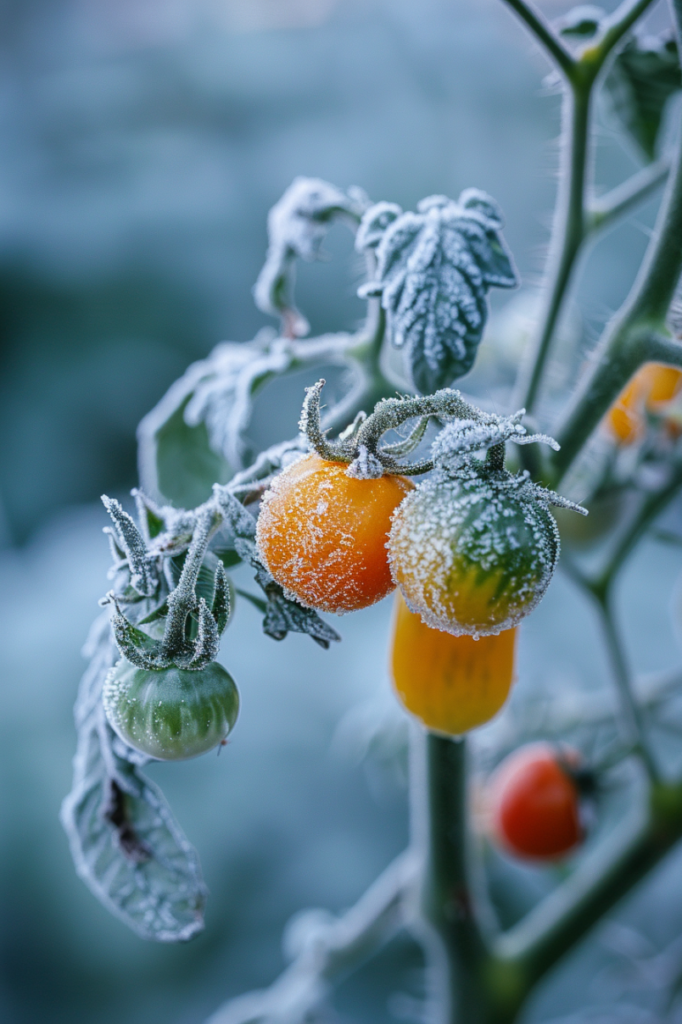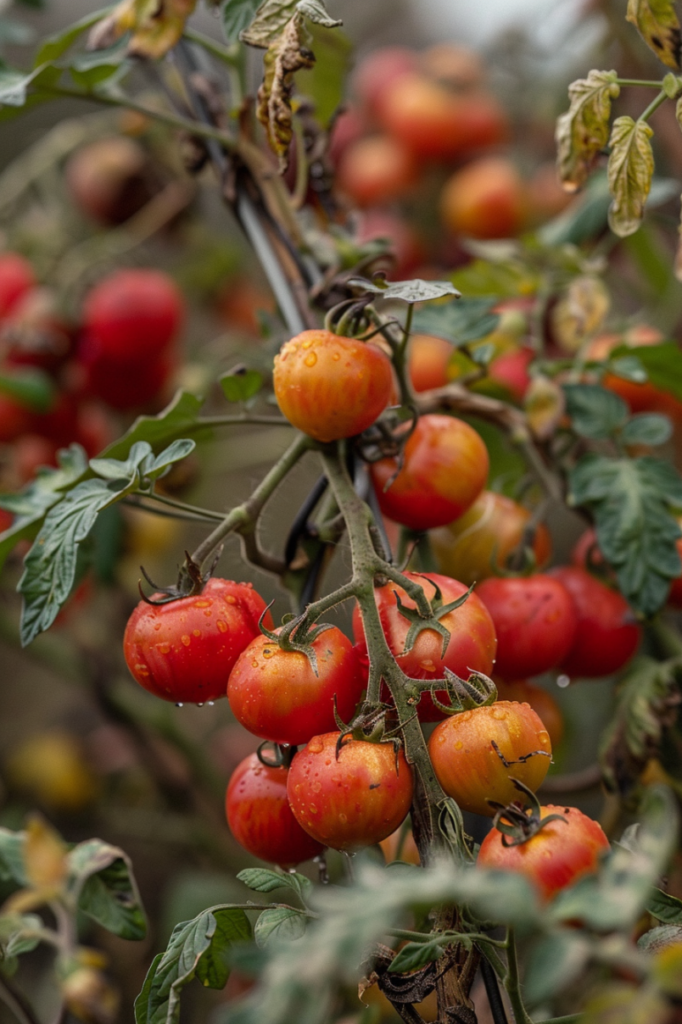
Tomatoes are a beloved garden staple, but when the temperatures drop, many gardeners face the challenge of keeping their plants alive through the winter.
Overwintering tomato plants is a method that allows you to preserve your favorite varieties and get a head start on the growing season.
This guide will walk you through the process of preparing, protecting, and maintaining your tomato plants during the winter months to ensure they stay healthy and productive.
Preparing Your Tomato Plants for Overwintering
Preparing your tomato plants for winter can help them survive the colder months and be ready to thrive again in the spring.
Here’s how you can get your tomatoes ready for overwintering:
Choose the right variety
Not all tomato plants are suited for winter conditions.
Look for varieties that are bred to handle cooler temperatures, like ‘Glacier’ or ‘Siberian.’
These types are more likely to survive and grow well even when it gets cold.
- Read also: Unlock the Secret: Tomato Plant Watering Schedule
- Read also: A Guide: Mastering the Art of Drip Irrigation for Tomatoes
Prune your plants
Pruning helps your tomato plants save energy and stay healthy.
Cut away any weak, damaged, or diseased branches. Trim the plant back to about 12 inches from the ground.
This makes it easier to manage and promotes healthier growth when spring comes.
Mulch around the base
Mulching is a great way to protect your tomato plants.
Apply a thick layer of organic mulch, such as straw, leaves, or bark chips, around the base of the plants.
Mulch helps keep the soil temperature stable and retains moisture, acting like a blanket for the roots.
Provide adequate light
Tomato plants need lots of light to stay healthy.
Place your plants in a sunny spot where they can get at least 6 hours of direct sunlight each day.
If you don’t have enough natural light, you can use grow lights to make sure your plants get the light they need.

Protecting Your Tomato Plants from Frost
Frost can be a major threat to your tomato plants, but with the right precautions, you can help them survive and thrive.
Here are some effective methods to protect your tomato plants from frost:
Cover your plants
One of the simplest ways to protect your tomato plants from frost is to cover them.
You can use a frost blanket, old sheets, or even lightweight tarps.
Make sure to drape the cover over the plants before nightfall when temperatures drop.
Secure the edges of the cover with rocks or stakes to prevent it from blowing away in the wind.
This extra layer acts like a blanket, providing insulation and keeping the cold air away from the plants.
Use row covers
Row covers are specially designed, lightweight fabrics that provide protection from frost while allowing light and moisture to reach your plants.
They are easy to set up: simply drape them over your tomato plants and secure them with stakes or soil.
Row covers can be left in place during the day and night, providing continuous protection.
When the weather warms up, you can easily remove the covers. These covers are reusable and can be a great investment for your garden.
Bring your plants indoors
If you live in an area where temperatures get extremely cold, consider bringing your tomato plants indoors for the winter.
Find a sunny spot, such as near a south-facing window, or set up grow lights in a basement or garage.
Ensure that the indoor environment stays warm and that the plants receive enough light.
This method offers the best protection against harsh winter conditions, as it keeps the plants completely out of the cold.
Additional Tips for Frost Protection
- Watering: Water your plants thoroughly before a frost. Wet soil retains heat better than dry soil, which can help protect the roots.
- Mulching: Add a thick layer of mulch around the base of your plants to insulate the soil and roots.
- Timing: Monitor weather forecasts closely. If a frost is predicted, take action to cover or move your plants before temperatures drop.

Keeping Your Tomato Plants Healthy and Productive
Maintaining the health and productivity of your tomato plants requires consistent care and attention.
Here’s how you can keep your plants thriving:
Water your plants
Watering is crucial for healthy tomato plants.
Ensure the soil remains consistently moist but not waterlogged.
Overwatering can lead to root rot, while underwatering can stress the plants.
To check the moisture level, stick your finger about an inch into the soil.
If it feels dry, it’s time to water.
Water your plants at the base to keep the leaves dry and reduce the risk of diseases.
Fertilize your plants
Tomato plants need regular feeding to grow strong and produce fruit.
Use a balanced fertilizer that provides essential nutrients like nitrogen, phosphorus, and potassium.
Follow the instructions on the fertilizer package to avoid overfeeding, which can harm the plants.
During winter, you may reduce the frequency of fertilization as the plant’s growth slows down.
This helps prevent nutrient buildup in the soil.
Monitor for pests
Pests such as aphids, whiteflies, and spider mites can be a problem, especially if you bring your plants indoors.
Check your plants regularly for any signs of pests, such as small holes in the leaves, sticky residue, or the pests themselves.
Use organic pest control methods like insecticidal soap or neem oil to treat infestations.
Regularly wiping down the leaves with a damp cloth can also help keep pests at bay.
Prune your plants
Pruning is essential for promoting healthy growth and maximizing fruit production.
Remove any dead or yellowing leaves, as well as any suckers – the small shoots that grow between the main stem and branches.
Pruning helps the plant focus its energy on producing fruit rather than excess foliage.
It also improves air circulation around the plant, reducing the risk of disease.
Additional tips
- Mulching: Apply a layer of mulch around the base of your plants to retain moisture and regulate soil temperature.
- Staking or caging: Support your plants with stakes or cages to keep them upright and prevent the stems from breaking.
- Light requirements: Ensure your plants get plenty of light, especially if you’ve moved them indoors. Use grow lights if necessary to provide adequate light.

- Read also: DIY Tomato Trellis Ideas: Make Your Garden a Blast from the Past
- Read also: Unexpected Allies: Best Companion Planting for Your Tomatoes
Conclusion
Overwintering tomato plants can be a rewarding process, allowing you to enjoy homegrown tomatoes earlier in the season.
By choosing the right varieties, properly preparing and protecting your plants, and maintaining their health, you can successfully carry your tomato plants through the winter months.
Follow these steps, and you’ll be on your way to a bountiful tomato harvest next year.
FAQs
Varieties such as ‘Glacier’ and ‘Siberian’ are specifically bred for cooler temperatures and are more suitable for overwintering.
Tomato plants need at least 6 hours of direct sunlight daily. If natural light is insufficient, use grow lights to supplement their light needs.
Organic mulches like straw, leaves, or bark chips are best. They help retain moisture and regulate soil temperature.
Use organic pest control methods such as insecticidal soap or neem oil to eliminate pests like aphids, whiteflies, and spider mites.
Keep the soil consistently moist but not soggy. Check the soil regularly and adjust your watering schedule as needed to maintain proper moisture levels.



